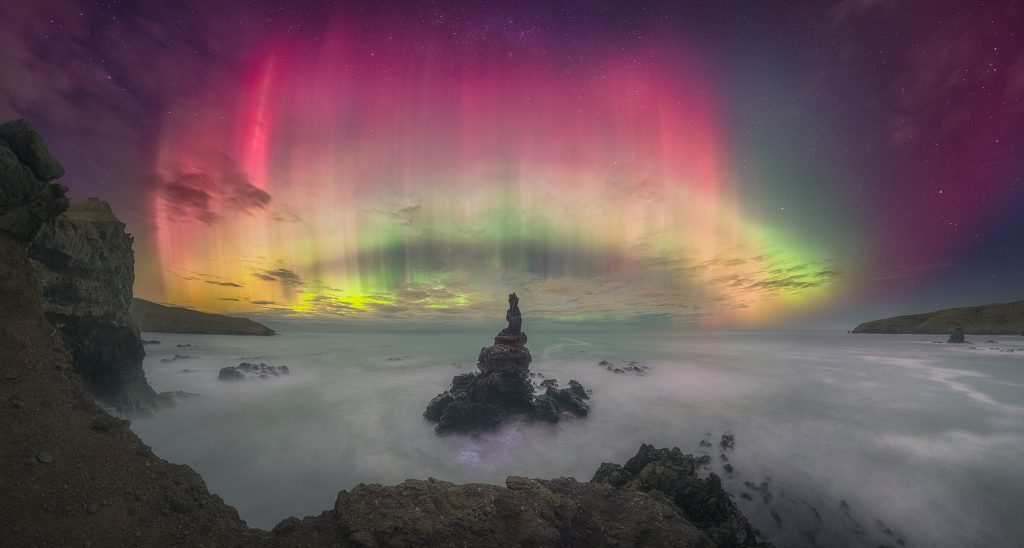When the biggest geomagnetic storm in 20 years hit Earth in May 2024, photographer Kavan Chay was in Tumbledown Bay, New Zealand. Armed with a Nikon Z 7 astro-modified camera, Chay captured a absolutely spectacular shot (seen above) of the vibrant aurora that resulted from the G5-level storm.
“The aurora pulsed throughout the night, almost like it was alive,” Chay wrote on Instagram. “It was breathtaking to watch and really made all my past week of anxious thoughts quiet. It’s incredible how nature can really help you with these things.” Chay’s image earned top honors in the Aurorae category of the 2025 Royal Observatory Greenwich’s ZWO Astronomy Photographer of the Year.
Winner
Comet 12P/Pons−Brooks reacted visibly to the intensified solar winds associated with the current solar maximum, creating a spectacle of tail dynamics and colourful hues expelled by its nuclear coma, the bright cloud of gas around the comet’s centre.
Credit: Dan Bartlett / ZWO ASTRONOMY PHOTOGRAPHER OF THE YEAR
A spectacular photographer titled “The Andromeda Core” (seen below) by Weitang Liang, Qi Yang, and Chuhong Yu took the Overall Winner prize.
“‘The Andromeda Core’ reveals an astonishing level of detail that truly took my breath away,” Sam Wen, Founder and CEO of ZWO said in a statement. “Achieving such clarity and depth requires not only top-tier astronomical equipment and exceptional seeing conditions, but also a tremendous amount of patience and perseverance. It’s clear that behind this image lies a dedicated team whose persistent effort and collaboration made this masterpiece possible. A brilliant capture of one of our closest galactic neighbours—congratulations on this outstanding achievement!”

Overall winner
This image showcases the core of the Andromeda Galaxy (M31) in exceptional detail, captured using a long focal-length telescope. Taking advantage of the excellent seeing conditions at Nerpio, the photographers focused on revealing the intricate structure of the galaxy’s central region and its surrounding stellar population.
Credit: Weitang Liang, Qi Yang, Chuhong Yu / ZWO ASTRONOMY PHOTOGRAPHER OF THE YEAR

Winner
This is the largest panorama Tom Rae has ever captured, with the full resolution image containing over a billion pixels from 62 images stitched together. The photograph captures the twin glacial rivers with the Milky Way core off to the left of the image, as well as the famous Southern Cross and other pointers high in the centre sky.
Credit: Tom Rae / ZWO ASTRONOMY PHOTOGRAPHER OF THE YEAR

Runner-up
This image showcases the iconic NGC 6960, also known as the Veil Nebula. To capture its intricate details and vivid colours, Zixiong Jin used a telescope, a cooled monochrome camera, an equatorial mount and a motorised filter wheel equipped with H-Alpha, OIII, SII, Red, Green, and Blue filters. For this particular target, the photographer cropped from a larger mosaic to better illustrate the concept and shape of the ‘veil’ by using a unique composition.
Credit: Zixiong Jin / ZWO ASTRONOMY PHOTOGRAPHER OF THE YEAR

Runner up
This image shows the tail-end of August’s lunar occultation of Saturn.
Although rare for any one location on Earth, 2024 saw a total of ten occultations occur across the globe! The event pictured here occurred near Saturn’s opposition and so coincided with the near-Full Moon.
Credit: Tom Williams / ZWO ASTRONOMY PHOTOGRAPHER OF THE YEAR

Runner-up
In the northern hemisphere, stars appear to rotate around Polaris, which lies near the north celestial pole. This motion, about 15 degrees per hour from east to west, is caused by Earth’s rotation. The giant Ferris wheel at Mirageland in Uozu only operates at night a few times a year, it stands at 66 m (216 ft) high and with a diameter of 62.5 m (205 ft). It takes about 15 minutes for the wheel to make a complete circle.
Credit: Takanobu Kurosaki / ZWO ASTRONOMY PHOTOGRAPHER OF THE YEAR Takanobu Kurosaki

Highly commended
The full Moon rising above the rugged peaks of the Dolomites. With no clouds in sight and in flawless conditions, the golden light of sunset bathes the mountains, creating harmony between Earth and sky.
Credit: Fabian Dalpiaz / ZWO ASTRONOMY PHOTOGRAPHER OF THE YEAR Fabian_dalpiaz

Winner
This image shows the International Space Station making a close pass of our Moon. The event was predicted to be a transit but ended up being a close flyby. However, the result is still dramatic, with the station’s solar arrays backlit by the rising Sun. Notably, the white radiators can also be seen and are illuminated by earthshine rather than direct sunlight.
Credit: Tom Williams / ZWO ASTRONOMY PHOTOGRAPHER OF THE YEAR

Highly commended
During a routine time-lapse observation of the solar chromosphere [thin, reddish layer of the Sun’s atmosphere above the visible surface], Zhang Yanguang captured a serendipitous moment frozen in time.
Credit: Zhang Yanguang / ZWO ASTRONOMY PHOTOGRAPHER OF THE YEAR

Highly commended
This image shows various objects, from dark nebulae to reflection nebulae and even some distant galaxies. All the nebulae in the foreground are part of the Cepheus molecular cloud complex, a network of molecular clouds (650 to 1,500 light years from Earth) where new stars are born. Some areas are lit up by the newborn stars themselves, while others are so dense that they block the optical spectrum of light coming from behind them. The largest objects in the image are the Shark Nebula (LDN 1235) and the Rotten Fish Nebula (LDN 1251).
Credit: Daniele Borsari / ZWO ASTRONOMY PHOTOGRAPHER OF THE YEAR

Highly commended
This image shows Mars, when it became retrograde [the apparent backward motion of a planet] in late May 2024, near M44, the Beehive Cluster.
This image superimposes photos of the Red Planet taken every five days, starting on 16 November (bottom right) and ending on 26 December (top right), allowing us to glimpse its movement towards the east, until it reverses on 6 December and starts moving west.
The planet is not really moving backwards, but the different orbit velocities of Earth and Mars, in this instance, create this optical illusion, known since ancient times, and is likely one of the reasons that some stars became known as ‘wanderers’ or, in ancient Greek, planetes.
Apparent retrograde motion happens at different places along the ecliptic [the Sun’s apparent path through sky] but, serendipitously, this time occurred near one of the most beautiful star clusters in the northern hemisphere, the Beehive Cluster.
Credit: Andre Vilhena / ZWO ASTRONOMY PHOTOGRAPHER OF THE YEAR

Winner
This photograph captures a serendipitous moment when a brilliant fireball from the Perseid meteor shower appears to graze M31, the Andromeda Galaxy.
Originally the photographers had only planned to capture a close-up of the M31 galaxy. Retrieving the camera the next morning, they discovered this wonderful surprise.
Credit: Yurui Gong, Xizhen Ruan / ZWO ASTRONOMY PHOTOGRAPHER OF THE YEAR

Highly commended
This full-spectrum image of the Spaghetti Nebula unveils the faint and elusive nature of this supernova remnant (SNR), hidden behind a vast cloud of dust that obstructs its emission light. To enhance its visual appeal, Shaoyu Zhang dedicated considerable time to capturing OIII data, intensifying the blue and green hues, while allowing SII and H-alpha to support high dynamic range stretching for added depth.
Credit: Shaoyu Zhang / ZWO ASTRONOMY PHOTOGRAPHER OF THE YEAR

Runner up
This image shows an intense aurora, forming an immense arc that spanned more than 180º. A gigantic and perfect green neon sign illuminated the entire sky.
Credit: Luis Vilariño / ZWO ASTRONOMY PHOTOGRAPHER OF THE YEAR

Highly commended
This image captures the conjunction of the Moon and Saturn, when they were exceptionally close in the night sky. It was an ideal night for astrophotography, with clear skies providing perfect visibility. The image is a seven-panel mosaic, carefully stitched together to showcase the Moon’s surface in stunning detail and Saturn in its full glory against the black backdrop of space.
Credit: Shamiqh Gajdhar / ZWO ASTRONOMY PHOTOGRAPHER OF THE YEAR

Highly commended
This Moon close-up shows, among other things, the main crater Aristarchus with its nine secondary craters. It has a diameter of 40 km (25 miles) and is located in a region visible on the front side of the lunar surface.
Credit: Raul Cantemir / ZWO ASTRONOMY PHOTOGRAPHER OF THE YEAR

Highly commended
On 7 November 2024, the Sun experienced a massive solar prominence eruption, with a length exceeding 500,000 km (311,000 miles). The eruption lasted approximately one hour from its initial outburst to its conclusion. The eruption phase of the prominence is composed of more than 20 stacked data sets highlighting the entire process of this spectacular event.
Credit: PengFei Chou / ZWO ASTRONOMY PHOTOGRAPHER OF THE YEAR


